Freesias are the single most eye-catching flower you can grow and their bright blooms continue flowering for at least six weeks, and up to two months with the right care. If you’re growing them as cut flowers in raised beds, they’ll do best with good spacing, and their stems stay rigid for longer when cut too, but they work just as well dotted into a mixed border.
For more tips on growing freesias at home in Australia, follow this guide to make the most of these stunning bulbs.
More...

Family: | Iridaceae |
|---|---|
Genus: | Freesia |
Species: | Various |
Common Name: | Freesia |
Origin: | Eastern Southern Africa (South Kenya to Eastern South Africa) |
Location: | Outdoor |
Type: | Herbaceous perennial |
Growth: | 40-50 cm tall |
Sun requirements: | Full sun |
Foliage Colour: | Green |
Flower Colour: | various |
Flowering: | Summer |
Fruits: | None |
Maintenance level: | Medium |
Poisonous for pets: | Non-toxic to cats and dogs |
What are Freesias?
Freesias are tender perennials, so cooler parts of Australia will need to protect them against even the risk of frost, but in warmer parts of the country, they can be grown as a border perennial with no winter care.
They flower from slender, papery corms, and spread by bulb multiplication and seed, so if you want to maintain a specific colour palette, make sure you deadhead them, otherwise they can cross-pollinate, and create variations in your borders.
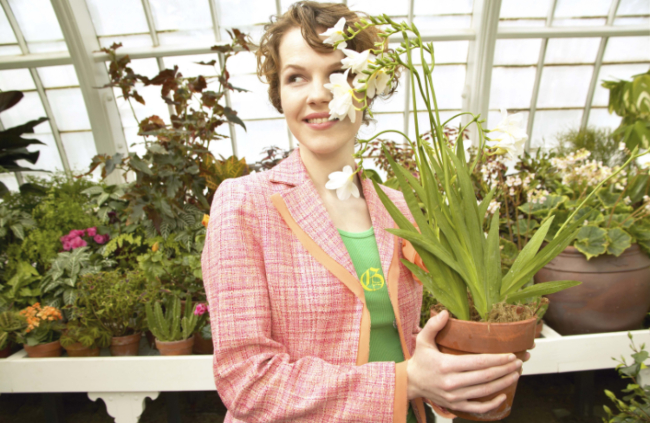
Typically growing to around 40 cm tall, most freesias develop elegant sword-shaped leaves and two or three flowering spikes. Their flowers open in sequence, usually from the lowest bud of the tallest spike, opening the next flower as the first fades.
Natural Habitat of Freesia
Freesias grow in hot, open spaces throughout southern Africa, with their northernmost habitats found in south Kenya, and limited to the eastern parts of South Africa.
In some parts of Australia, freesias have spread so rapidly that they are considered a weed, rather than a wildflower, with many species adapted even to frosty parts of the country.
Best Freesia Varieties to Grow in Australia
Freesias are a varied group of plants, with some true species varieties available in cultivation, but also many bred cultivars, developed for more vivid colours, of more unique patination on the petals.
Below, we’ve put together a list of twenty of our favourite freesia varieties to grow in Australia.
1. Freesia albaFreesia alba is a species of freesia, growing true to nature, with bright white, sometimes creamy flowers. It’s a vigorous flowering plant, which forms dense clumps so will need dividing every three or four years as a minimum, but makes a great low-maintenance freesia for Australian gardens. | 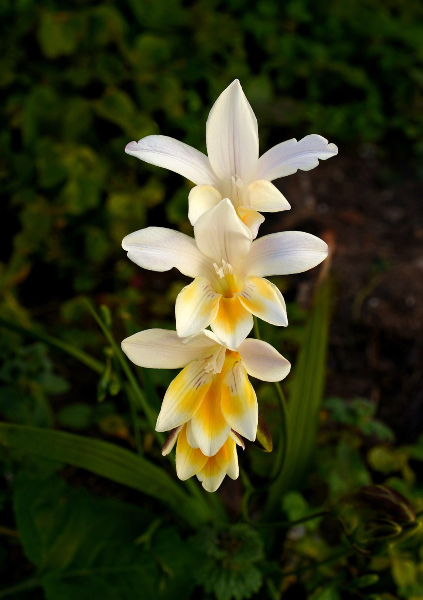 Source: Wikipedia |
2. Freesia ‘Blue Moon’In all my years of gardening, I’ve never come across a gentler violet than Freesia ‘Blue Moon’. The intense fragrance of each and every flower lasts in a vase and can fill your garden with afternoon scent. Their flower spikes are longer than normal too, so they have a slightly longer natural flowering period than some other cultivars, with a sequence of between eight and ten blooms on each stalk. |  Source: RHS Plants |
3. Freesia ‘Double Pink’These simple double freesias are intensely coloured, and equally fragrant, with gradated pinks on every petal. Their buds are just as lovely as the flowers too, so for a few weeks in early spring, you’ll have the beautiful promise of flowers, before the real show starts in early summer. | 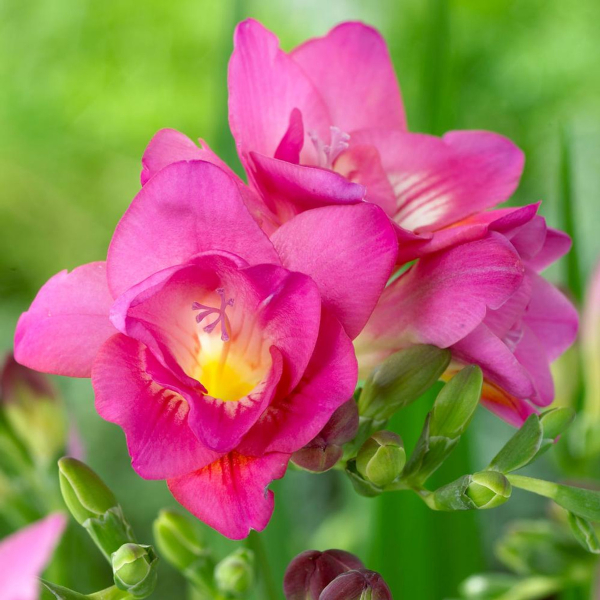 Source: Longfield Gardens |
4. Freesia ‘Fragrant Sunburst’Visually, Freesia ‘Fragrant sunburst’ isn’t going to win any awards, looking slightly like a faded daffodil, but it’s a great way to continue spring colour into your summer borders while adding an unmatched fragrance. These hardy, easy-to-grow perennials are great for cooler parts of the country and work just as well in a lawn meadow as they do in the border. | 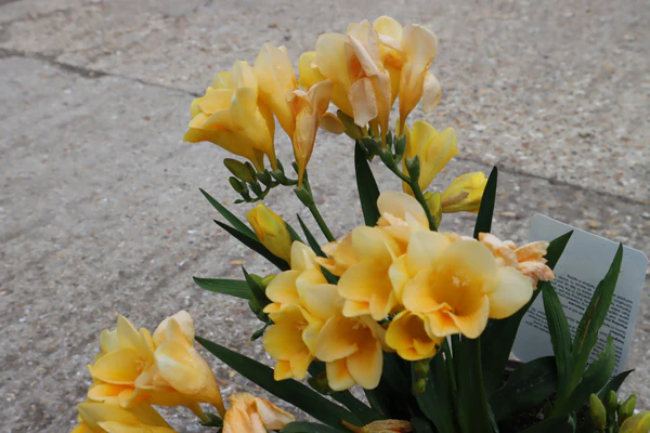 Source: St Margarets Nursery |
5. Freesia ‘Gold River’Gold River is a perfect compromise if you want some fragrance, but blousier blooms. With generous flower spikes, packed with blooms until early autumn, these freesias have it all. They might not be as fragrant as some, but they still pack a beautiful punch in a vase or bouquet. | 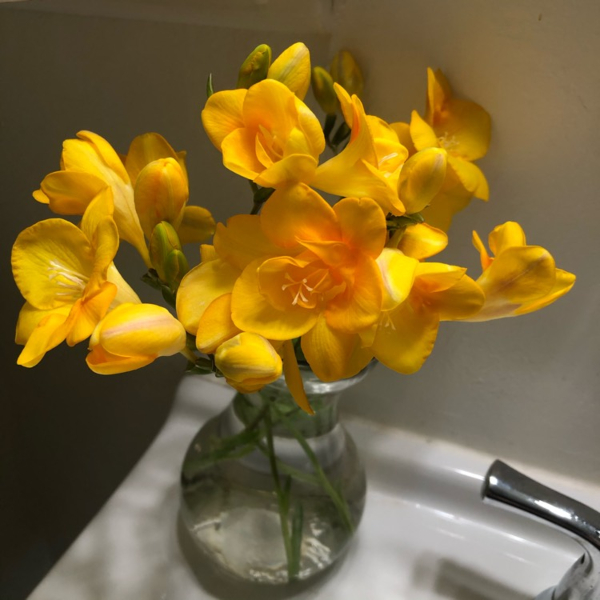 Source: GardenTags |
6. Freesia lacteaOne truly mesmerising, but dainty freesia is the unusual Freesia lactea, which is properly defined as an alpine freesia, growing in cooler, more mountainous conditions, and quite happy to grow in poor soil both indoors and out. Its very open flowers look similar to lilies (which makes sense when you look at the family tree) but with the unmistakable scent of freesia. | 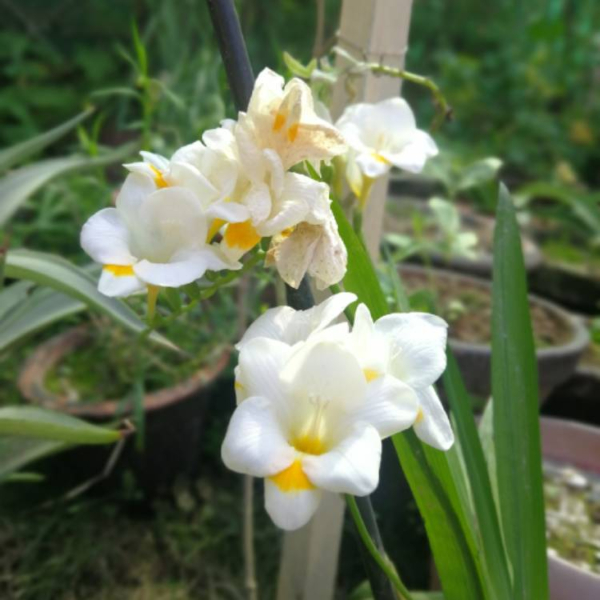 Source: GardenTags |
7. Freesia laxaWith its dense, clump-forming habit, tough-bladed foliage, and ability to cope with intense competition, Freesia laxa has truly earned its common name; flowering grass. Planted into grass or meadow wildflower, it will establish well and float effortlessly over long grass with a similar weight to Crocosmia, but a more pastel colouring. The spotted petals add interest, and its gentle fragrance is wonderful. | 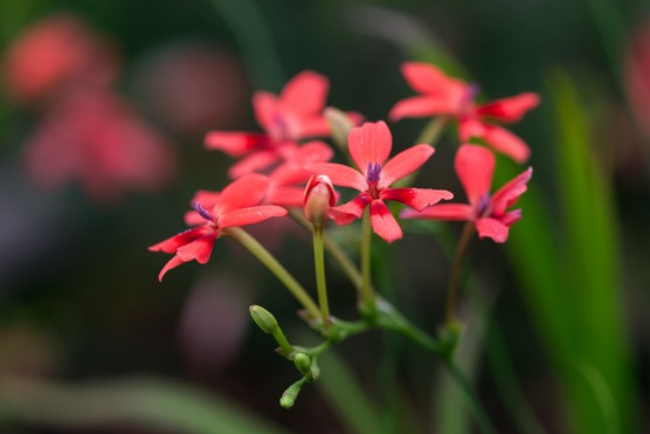 Source: Gardeners World |
8. Freesia laxa var. albaThe white form of Freesia laxa, Freesia laxa var. alba, is a gentle woodland freesia that actually works in part shade, or even dappled shade for most of the day. It’s not as bold as most other freesias, but it’s well worth considering for a more natural vibe in your garden. | 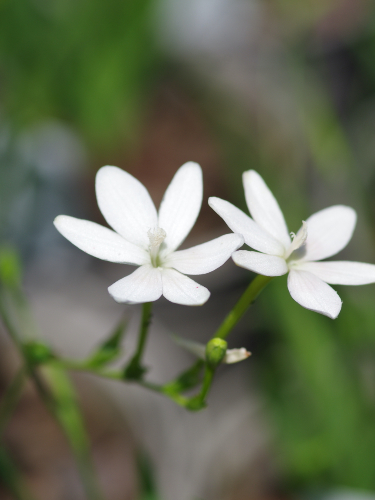 Source: Beth Chatto Gardens |
9. Freesia ‘Oberon’With smaller flowers than ‘Marianne’, Freesia ‘Oberon’ is perhaps not at the top of your shopping list, but with shorter stems, and smaller flowers, some a new tier of planting for your garden. Most freesias are mid-layer plants, most welcome in the centre of a border. If you want to bring that colour and scent to the front of your borders, these shortened varieties are ideal. | 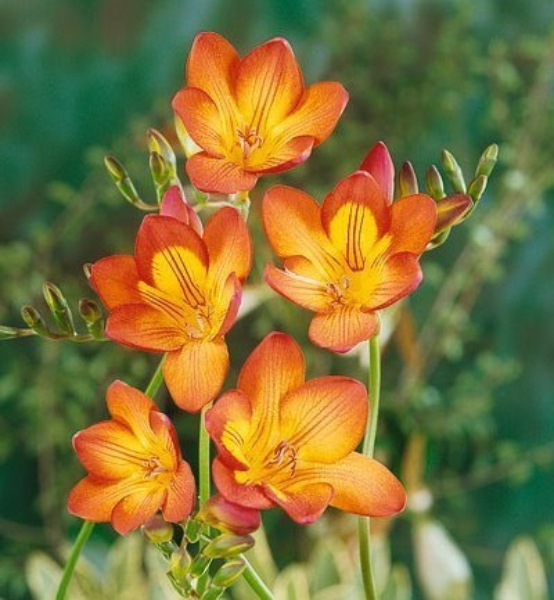 Source: The Plant Company |
10. Freesia ‘Purple Rain’Freesia ‘Purple Rain’ grows well in any bright, well-drained conditions. Its sweet purple flowers stand tall and proud on upright stems, adding structure to your garden, whether you choose to plant them in rockeries or gravel gardens, or straight into a border. | 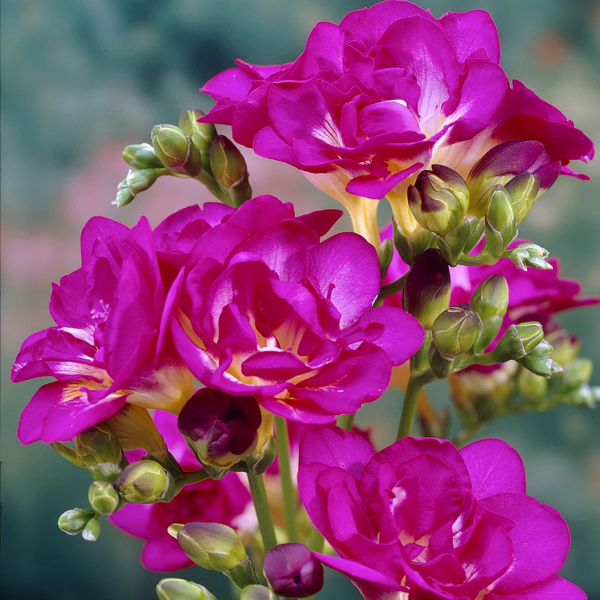 Source: Plantcetera |
11. Freesia ‘Pink Devotion’With its neatly arranged petals, Freesia ‘Pink Devotion’ is a great flower for anyone wanting to explore cut flowers, and develop a perennial flower bed without having to do too much work. Pink Devotion is very much powder pink, so won’t be to everyone’s taste, but if you can find the right spot for it in your garden it can perfectly tie another dusty planting together. | 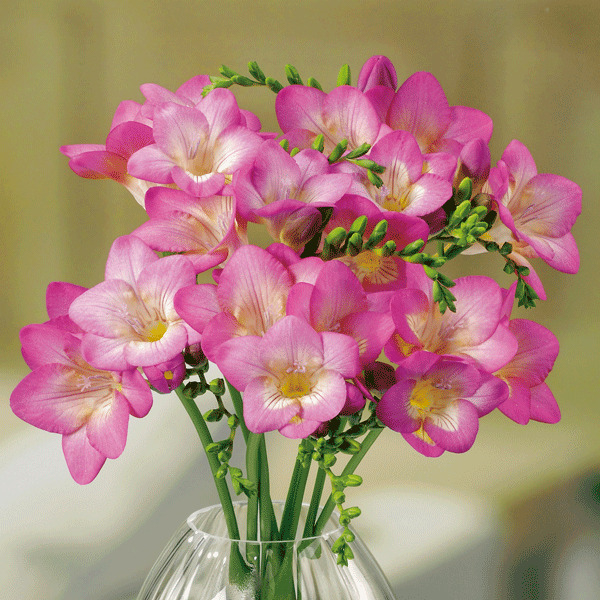 Source: Garden Express |
12. Freesia ‘Red Beauty’Freesia ‘Red Beauty’ is a highly perfumed freesia that boasts the iconic natural red colouring of many natural species freesias. For something both blousy and natural at the same time, Red Beauty is one of the best possible choices for your garden. |  Source: Tesselaar |
13. Freesia ‘Red River’This cultivar's conical crimson flowers are gorgeously structural, but it’s their burgundy flower buds that really sets them apart for me. Each bud, before it opens, is tipped with an increasingly bulbous burgundy case, which springs out into one of the brightest red flowers you could wish for in your garden, and it’s not just style, there’s substance here too, as Freesia ‘Red River’ is a tough perennial that will repeat flower even after a cold winter. | 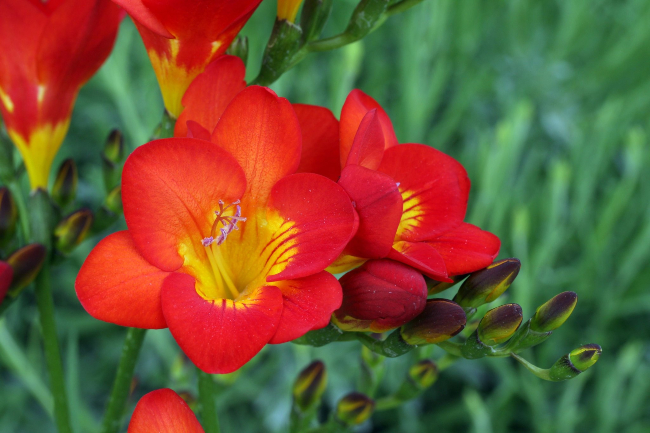 Source: Stewarts Garden Centres |
14. Freesia ‘Striped Pearl’Freesias really do come in all forms, but Striped Pearl has to be one of the most unusual there is, with a veined petal, which only improves with age. As your freesias begin to naturalise, and adapt to your garden, the purple veins over the pearly white petals become darker, producing ever-more stunning flowers. | 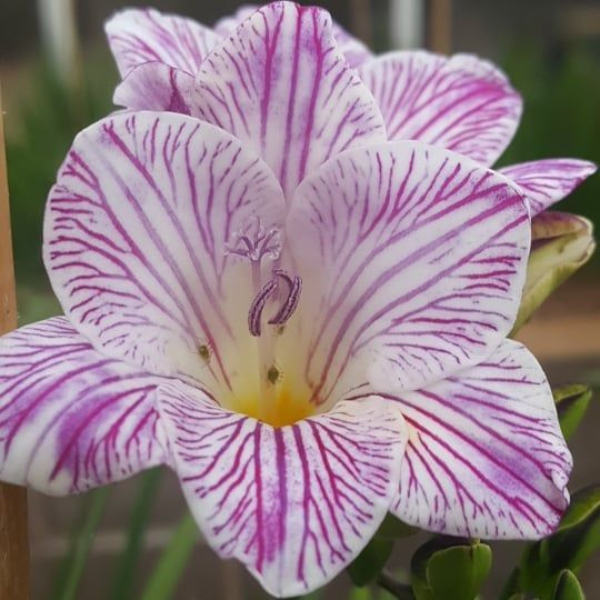 Source: Pinterest |
15. Freesia ‘Vienna’The double-flowered Freesia ‘Vienna’ is named, I imagine, for the sheer romance of its flowers, with bright, crisp, and silky flowers, and multiple stems per plant, leading to a dense display of flowers from each corm. | 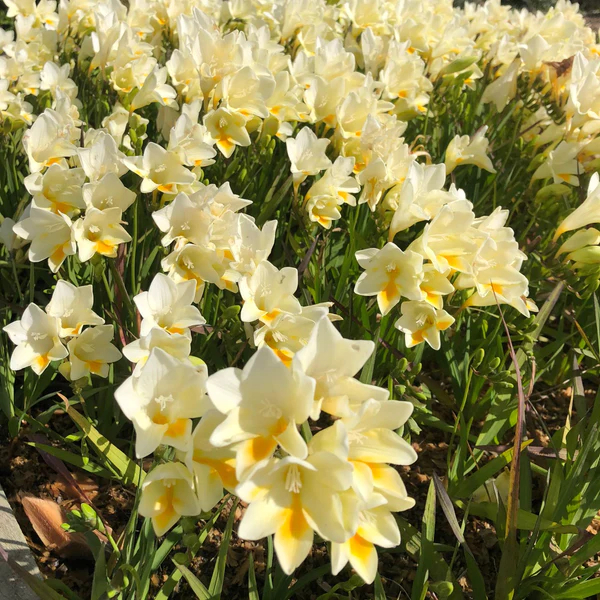 Source: Bulbs Direct |
16. Freesia ‘Volcano’Freesia ‘Volcano’ is a matt-coloured red Freesia, without the yellow centre, making it much easier to add to red-themed planting, or to use as a foil to white freesias without muddying the arrangements with pops of yellow. The appeal of most freesias, as well as their scent, is often the variation in flower, but for something a little more controlled, it’s worth hunting out some Freesia ‘Volcano’ corms. | 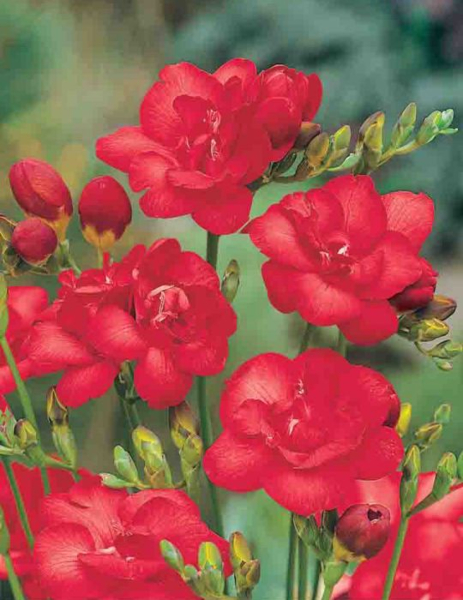 Source: Mr Fothergill's |
17. Freesia ‘White River’This list might be in alphabetical order, but Freesia ‘White River’ really is the headline act here. With more fragrant blooms than any I’ve grown, Freesia ‘White River’ is perfect for pots on the patio, and is completely safe for cats and dogs, so can be used as a wonderful alternative to white lilies, both indoors and out. Provide Freesia ‘White River’ with nutritious compost and good drainage in equal measure, and you’ll have stunning flowers that need diving once every few years, to easily double your stock. | 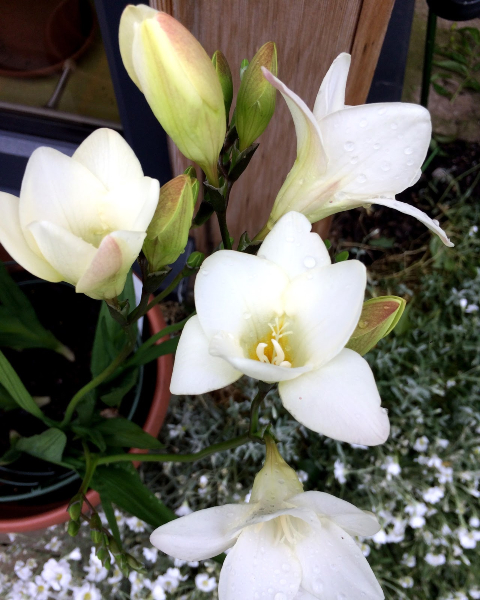 Source: Gardener's Word |
18. Freesia ‘Belleville’Freesia ‘Belleville’ is a very ornamental freesia, with blousy blooms that last for up to a week as cut flowers, or bloom for 4-6 weeks in most gardens. They are very distinctly double-flowered, meaning they have dense clusters of petals, and a higher impact in borders, though are less useful for wildlife as their pollen centres are inaccessible. | Cell |
19. Freesia ‘Marianne’Single-blooming freesias are better for wildlife but rarely have the bright and structural punch of double-bloomed freesias. Freesia ‘Marianne’ proves this wrong in buckets though, with a bold, bright flower, with a sun-burst colouring from a bright custard-yellow centre, to dense strawberry-red borders. Any bright, well-drained spot will see these stunning freesias displaying colourful blooms through to the end of summer. | Cell |
20. Freesia ‘Yvonne’Another bright, bright, yellow Freesia is ‘Yvonne’, which can be cut early, and will continue developing flowers for well over a week in a vase. In the garden, Yvonne looks best as a mid-layer plant, where it can be used to lead the eye through borders, rather than standing out too proudly by itself, which can distract from other more delicate planting. | Cell |
1. Freesia alba

Source: Wikipedia
Freesia alba is a species of freesia, growing true to nature, with bright white, sometimes creamy flowers. It’s a vigorous flowering plant, which forms dense clumps so will need dividing every three or four years as a minimum, but makes a great low-maintenance freesia for Australian gardens.
2. Freesia ‘Blue Moon’

Source: RHS Plants
In all my years of gardening, I’ve never come across a gentler violet than Freesia ‘Blue Moon’. The intense fragrance of each and every flower lasts in a vase and can fill your garden with afternoon scent.
Their flower spikes are longer than normal too, so they have a slightly longer natural flowering period than some other cultivars, with a sequence of between eight and ten blooms on each stalk.


Get Your Free Guide:
Master Growing Australian Natives eBook
A Must Have Complete Guide for Every Australian Garden
Get Your Free Guide:
Master Growing Australian Natives eBook
A Must Have Complete Guide for Every Australian Garden
3. Freesia ‘Double Pink’

Source: Longfield Gardens
These simple double freesias are intensely coloured, and equally fragrant, with gradated pinks on every petal. Their buds are just as lovely as the flowers too, so for a few weeks in early spring, you’ll have the beautiful promise of flowers, before the real show starts in early summer.
4. Freesia ‘Fragrant Sunburst’

Source: St Margarets Nursery
Visually, Freesia ‘Fragrant sunburst’ isn’t going to win any awards, looking slightly like a faded daffodil, but it’s a great way to continue spring colour into your summer borders while adding an unmatched fragrance.
These hardy, easy-to-grow perennials are great for cooler parts of the country and work just as well in a lawn meadow as they do in the border.
5. Freesia ‘Gold River’

Source: GardenTags
Gold River is a perfect compromise if you want some fragrance, but blousier blooms. With generous flower spikes, packed with blooms until early autumn, these freesias have it all.
They might not be as fragrant as some, but they still pack a beautiful punch in a vase or bouquet.
6. Freesia lactea

Source: GardenTags
One truly mesmerising, but dainty freesia is the unusual Freesia lactea, which is properly defined as an alpine freesia, growing in cooler, more mountainous conditions, and quite happy to grow in poor soil both indoors and out.
Its very open flowers look similar to lilies (which makes sense when you look at the family tree) but with the unmistakable scent of freesia.
7. Freesia laxa

Source: Gardeners World
With its dense, clump-forming habit, tough-bladed foliage, and ability to cope with intense competition, Freesia laxa has truly earned its common name; flowering grass.
Planted into grass or meadow wildflower, it will establish well and float effortlessly over long grass with a similar weight to Crocosmia, but a more pastel colouring. The spotted petals add interest, and its gentle fragrance is wonderful.
8. Freesia laxa var. alba

Source: Beth Chatto Gardens
The white form of Freesia laxa, Freesia laxa var. alba, is a gentle woodland freesia that actually works in part shade, or even dappled shade for most of the day. It’s not as bold as most other freesias, but it’s well worth considering for a more natural vibe in your garden.
9. Freesia ‘Oberon’

Source: The Plant Company
With smaller flowers than ‘Marianne’, Freesia ‘Oberon’ is perhaps not at the top of your shopping list, but with shorter stems, and smaller flowers, some a new tier of planting for your garden.
Most freesias are mid-layer plants, most welcome in the centre of a border. If you want to bring that colour and scent to the front of your borders, these shortened varieties are ideal.
10. Freesia ‘Purple Rain’

Source: Plantcetera
Freesia ‘Purple Rain’ grows well in any bright, well-drained conditions. Its sweet purple flowers stand tall and proud on upright stems, adding structure to your garden, whether you choose to plant them in rockeries or gravel gardens, or straight into a border.
11. Freesia ‘Pink Devotion’

Source: Garden Express
With its neatly arranged petals, Freesia ‘Pink Devotion’ is a great flower for anyone wanting to explore cut flowers, and develop a perennial flower bed without having to do too much work.
Pink Devotion is very much powder pink, so won’t be to everyone’s taste, but if you can find the right spot for it in your garden it can perfectly tie another dusty planting together.
12. Freesia ‘Red Beauty’

Source: Tesselaar
Freesia ‘Red Beauty’ is a highly perfumed freesia that boasts the iconic natural red colouring of many natural species freesias. For something both blousy and natural at the same time, Red Beauty is one of the best possible choices for your garden.
13. Freesia ‘Red River’

Source: Stewarts Garden Centres
This cultivar's conical crimson flowers are gorgeously structural, but it’s their burgundy flower buds that really sets them apart for me.
Each bud, before it opens, is tipped with an increasingly bulbous burgundy case, which springs out into one of the brightest red flowers you could wish for in your garden, and it’s not just style, there’s substance here too, as Freesia ‘Red River’ is a tough perennial that will repeat flower even after a cold winter.
14. Freesia ‘Striped Pearl’

Source: Pinterest
Freesias really do come in all forms, but Striped Pearl has to be one of the most unusual there is, with a veined petal, which only improves with age. As your freesias begin to naturalise, and adapt to your garden, the purple veins over the pearly white petals become darker, producing ever-more stunning flowers.
15. Freesia ‘Vienna’

Source: Bulbs Direct
The double-flowered Freesia ‘Vienna’ is named, I imagine, for the sheer romance of its flowers, with bright, crisp, and silky flowers, and multiple stems per plant, leading to a dense display of flowers from each corm.
16. Freesia ‘Volcano’

Source: Mr Fothergill's
Freesia ‘Volcano’ is a matt-coloured red Freesia, without the yellow centre, making it much easier to add to red-themed planting, or to use as a foil to white freesias without muddying the arrangements with pops of yellow.
The appeal of most freesias, as well as their scent, is often the variation in flower, but for something a little more controlled, it’s worth hunting out some Freesia ‘Volcano’ corms.
17. Freesia ‘White River’

Source: Gardener's Word
This list might be in alphabetical order, but Freesia ‘White River’ really is the headline act here. With more fragrant blooms than any I’ve grown, Freesia ‘White River’ is perfect for pots on the patio, and is completely safe for cats and dogs, so can be used as a wonderful alternative to white lilies, both indoors and out.
Provide Freesia ‘White River’ with nutritious compost and good drainage in equal measure, and you’ll have stunning flowers that need diving once every few years, to easily double your stock.
18. Freesia ‘Belleville’
Freesia ‘Belleville’ is a very ornamental freesia, with blousy blooms that last for up to a week as cut flowers, or bloom for 4-6 weeks in most gardens.
They are very distinctly double-flowered, meaning they have dense clusters of petals, and a higher impact in borders, though are less useful for wildlife as their pollen centres are inaccessible.
19. Freesia ‘Marianne’
Single-blooming freesias are better for wildlife but rarely have the bright and structural punch of double-bloomed freesias. Freesia ‘Marianne’ proves this wrong in buckets though, with a bold, bright flower, with a sun-burst colouring from a bright custard-yellow centre, to dense strawberry-red borders.
Any bright, well-drained spot will see these stunning freesias displaying colourful blooms through to the end of summer.
20. Freesia ‘Yvonne’
Another bright, bright, yellow Freesia is ‘Yvonne’, which can be cut early, and will continue developing flowers for well over a week in a vase. In the garden, Yvonne looks best as a mid-layer plant, where it can be used to lead the eye through borders, rather than standing out too proudly by itself, which can distract from other more delicate planting.
How to Grow Freesias in Australia
Freesias need some very basic things to live happily, and after that, it's simply a case of timing your water. If you’ve got a spot that’s well-drained, in full sun, and won’t completely dry out in mid-summer, then you’re on to a winner.
To prepare your garden and provide those conditions, either in pots or on the ground, follow the guides below.
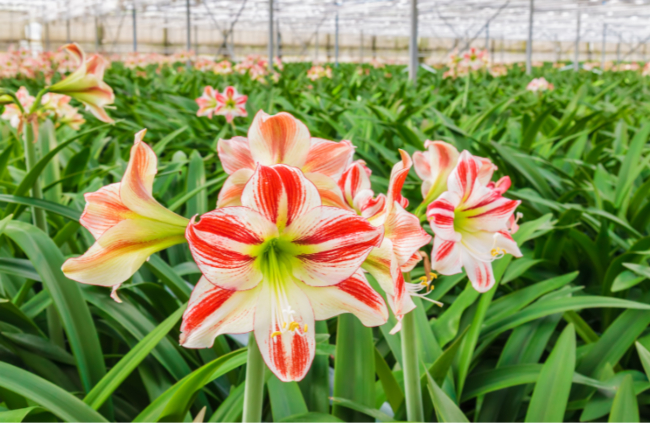
When to Plant Freesia Corms
Freesias are best planted in late autumn, or early winter, and protected from frost, but for prepared corms, they can be planted as late as early spring for summer flowering.
You can plant freesia corms quite tightly together in clumps or swathes, or play the long game and plant them 20 cm apart so they naturally develop their own clumps over a few years.
How to Grow Freesia Outdoors
Freesias will be happy outdoors in most gardens in Australia, but try your best to give them a minimum of 6 hours of direct sunlight every day. While they can tolerate part shade, they prefer their corms to warm up quickly earlier in the year, so planting in deep shade will limit their flowering window down to about a month, and lead to late development, which can lead to competition with other border plants.
Soil & Drainage
Any rich but well-drained soil is ideal, but even sandy soils can be easily improved with a loamy compost, leaf mould, or soil improver. The basic balance is between drainage and moisture retention, meaning that sandy soils are quite a good base for providing drainage.
Adding a layer of compost, or even digging it through provides nutrients and a little water retention so you don’t have to water quite as regularly in high summer.
Light & Temperature
Freesias need full sun to perform at their best. They are native to the eastern parts of southern Africa and are used to coping with extreme droughts, and extreme rainfall, paired particularly with high humidity.
The warmer and brighter your garden, the better, but make sure to manage watering so that they don’t completely dry out during the flowering season (from late spring through to late summer if you’re lucky).
Growing Freesias in Pots and Containers
If you’re going for balcony garden, or even if you don’t have your own garden, you can actually grow freesias quite successfully in pots indoors, or under shelter. However, the same rules as above apply. They will need good sun, regular watering, and a rich but well-drained compost mix.
If there is a risk of frost over winter, planting freesias in pots means they can be moved into a greenhouse or indoors for protection.
How to Propagate Freesias
Freesias are hard to grow in cooler climates, but here in Australia, they will virtually propagate themselves. To avoid them taking over your garden, deadhead spent flowers regularly, and if they do go to seed, save them for sowing in trays in late summer.
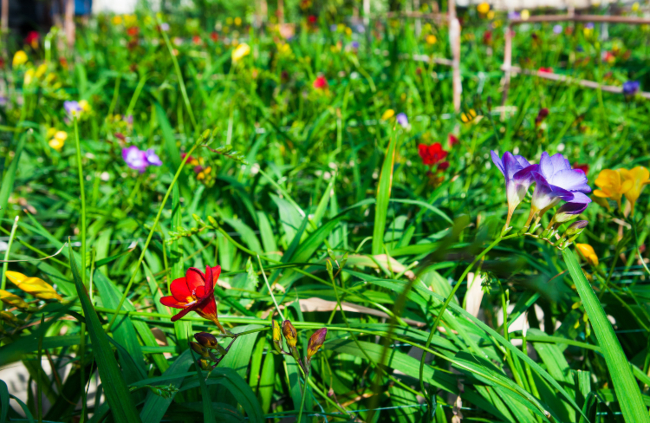
Propagating Freesias from Seed
Growing freesias from seed is a simple but lengthy process. All you need is a tray filled with seed compost, a mister, and somewhere dark to keep them. They take six months to germinate, and a full growing season to develop a corm.
Once the corm has developed (usually the summer after sowing), it will grow blind and can take two or three years to flower.
- Soak freesia seeds for 24 hours to soften the hard coating.
- Fill a seed tray with compost or sieved garden soil.
- Soak the tray, and cover to block out light.
- Store the tray somewhere warm that stays between 15-18°C
- Check for germination once a week after the first month, but be prepared to wait for up to six months.
- When seedlings are large enough to handle, prick them out into individual small pots to grow outdoors.
Propagating Freesias from Bulbs & Division
Freesias grow from papery bulbs known as corms, which store energy and multiply underground.
To propagate freesias from stored corms, simply plant them at two or three times their depth in loose soil, and water them well. Continue watering once they have sprouted out above the soil, and keep the ground moist but not soaked until they stop flowering at the end of summer.
Once your freesias have established, their corms will spread out underground to create dense clumps. These clumps can be lifted and divided, or you can dig out small sections in early spring when foliage emerges from the ground.
By dividing them early in the year, you give them a full growing season to recover from being moved, and will usually see flowers from all new clumps in the same year.
How to Care for Freesias
Once established, freesias in Australia require very little care or attention, but you can prolong their flowering season by deadheading, attentive watering, and a compost-base feed in spring.
Follow the steps below for the ultimate care guide to support established freesias.
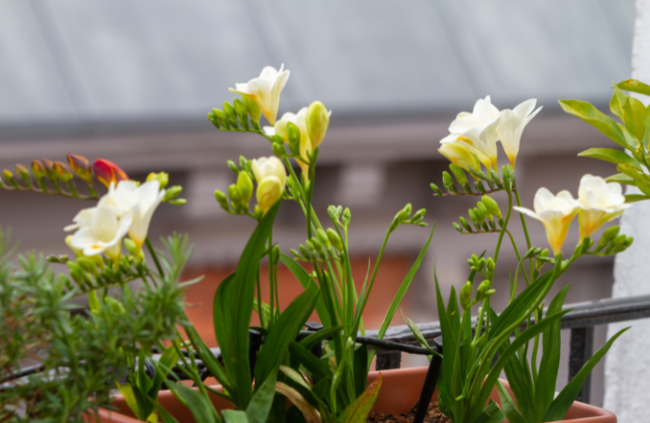
Mulching and Feeding Freesias
Freesias rarely need frost protection in Australia, but a winter mulch will protect bulbs from most frosts. The best time to mulch is in spring, specifically with leaf mould or a 2 cm thick layer of garden compost.
Both are packed with nutrients and will be worked into the soil naturally to fertiliser the bulbs, as well as keeping the soil moist below the mulch through summer.
Water Requirements
Freesias are drought-tolerant, but perform better with a bit of fuss. Watering deeply once a week from early spring, rather than frequent sprinkling, will support better flowering in summer.
Like all bulbs and corms, their worst enemy in winter is cold, stagnant water, so avoid watering them once the foliage begins to die back.
Repotting
Freesias multiply their corms at a manageable rate, so are a good summer bulb for pots, but when their foliage begins to press up against the side of a container it’s time to tip them out and divide.
Freesias don’t mind competition, or compaction, and can often flower better in cramped conditions, but they will eventually split their pots. As standard, repot freesias or divide them every three years.
Deadheading freesias
Deadheading isn’t necessary for freesias, as they send up a finite amount of flower spikes, which will all flower in sequence. However, deadheading will prevent your freesias from wasting energy on seed production by pollinating flowers, and focusing energy back to the bulb after flowering.
Leave the foliage to die back naturally, which feeds the bulb for next year’s display.
Storing freesia bulbs
Freesia bulbs, like any bulbs, need to be stored in a dark, dry climate away from any humidity or high levels of moisture. If they start sprouting prior to autumn then they most likely won’t last the distance.
If you’ve dug them up from another part of your garden then wash all the soil off and leave to dry in a place that will allow this to occur quite quickly. Make sure that the freesia bulbs are able to be surrounded by air as this will keep them in peak condition ready for planting.
Common Freesia Pests and Diseases
Frost is the main cause of damage and corm rot for freesias, as is sitting in water over winter. Other than that, freesias are susceptible to most common bulb and cormous plant infections, and the same pests as any other bulbous perennial.
Mice and Small Mammals
Mice, rats, and other small mammals will eat bulbs if they can get to them. If you have a known rodent population, it’s worth sprinkling ground chilli flakes over the soil around where you’ve planted freesias.
Established clumps will be ok, but protect newly planted freesia corms from digging by using peppery defences!
Aphids and Spider Mites
Aphids love the flower shoots of freesias, but can simply be scraped off to remove them. Spider mites are harder to get rid of, but by watering the soil a little more often you’ll generally find that they go away by themselves as they only thrive in dry conditions.
Slugs and Snails
Slugs and snails do seem to have a taste for freesias, so while most bulbs will be safe against their slippery attacks, try scattering lightly crushed eggshells around the clumps of freesias, or over the soil where you planted them.
Fungal Leaf Spots and Moulds
Fungal leaf spots and moulds can badly affect freesias in damp or overly humid conditions and should be removed when noticed, with any affected foliage burned to stop the spread.
Aside from that, there are a handful of other viruses and bacterial problems that can affect freesias, but most are preventable with well-managed soil moisture, and regular pest checks.
Final Tips for Freesias
Plant them amongst other similar sized plants so that they can intertwine with them and produce a bold colourful statement.
Plant them in a small container and then bury the pot in the location you are wanting them to grow. The benefit of this little tip is that once all the flowers have died back you can lift the container and allow the foliage to die back without the unsightly view of browning leaves. It’s also easier to keep account of your bulbs for storage.
Fertilise them straight after all their flowering has finished. This helps the bulb grab enough strength to produce blooms for the following season.
Freesias Frequently Asked Questions

Do freesias come back every year?
Freesias are perennial plants, so will come back year after year in most parts of Australia. After a few years, you’ll notice that your freesias not only come back each year but multiply by developing new underground corms.
Can you leave freesia bulbs in the ground over winter?
Freesias aren’t fully hardy, so do need protection from frosts, and should be lifted if you expect a very wet winter too. Most Australian gardeners will be fine to leave freesia bulbs in the ground over winter.
What do you do with freesias after flowering?
After flowering, freesias can either be left to self-seed around the garden, or deadheaded to support the development of next year’s flowers and boost the natural feed that goes back into the bulb.
We suggest deadheading each flowering stem right back to the base when it finishes flowering, leaving the leaves to die back naturally.
Do slugs eat freesias?
Slugs eat freesias, but will rarely choose them over annual plants if they have a choice. To prevent slug attacks, lay crushed egg shells around the base of freesia plants to make it harder for them to get there.
For more information on planting summer bulbs, or for summer colour why not check out our guides to growing tiger lilies, clivias, and irises to compliment your freesias?
Wrapping Up Our Freesias Growing Guide
Freesias are utterly sumptuous plants, with flowers that last and last, providing stunning displays right through summer. For any gardener wanting a value-for-money plant that truly performs, growing your own freesias is a no-brainer.
Published on June 27, 2023 by Gary Clarke
Last Updated on September 20, 2024





Thank you Gary, very informative and just what I was looking for. Your efforts are appreciated. – Ken.
Hi Ken,
I’m glad to hear that the information was helpful and met your needs.
It’s always a pleasure to assist.
Best regards,
Gary